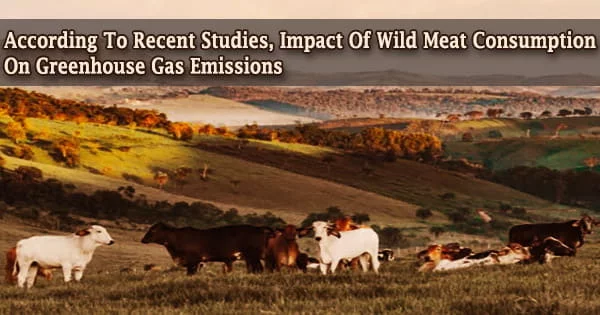Consuming responsibly produced wild meat rather than domesticated animals minimizes greenhouse gas emissions and preserves valuable tropical forest systems, hence mitigating climate change’s consequences.
According to a new study published today in the journal Scientific Reports by the University of East Anglia (UEA) and the Universidade Federal do Mato Grosso do Sul in Brazil. The researchers also calculated the worth of carbon credits emitted by tropical forest tribes that eat wild meat instead of farmed animals.
André Nunes of the Universidade Federal do Mato Grosso do Sul and Carlos Peres, Professor of Conservation Science at the University of East Anglia, studied people in Afrotropical and Neotropical countries such as Nigeria, Ghana, and Tanzania, as well as Brazil, Peru, and Bolivia, in collaboration with Brazilian and Danish colleagues.
Through PES and REDD+ programs, the team calculated potential revenue from the sale of linked carbon credits, as well as how this may offer financial incentives for forest conservation and sustainable wildlife management.
Payments for ecosystem services (PES) refers to a group of systems in which the recipients, or users, of ecosystem services, pay the stewards, or providers, of those services. REDD+ (Reduced Emissions from Deforestation and Forest Degradation) is an international carbon credit trading system that allows polluters in high-income countries to compensate low-income countries for decreasing deforestation and forest degradation.
Tropical grazeland expansion for ruminant livestock production to feed domestic meat consumption and exports is a double-jeopardy because we both lose the carbon stocks from formerly pristine old-growth forests and woody savannahs and generate a powerful perennial methane pump.
Carlos Peres
The researchers calculated that an annual per capita intake of 41.7kg of wild meat would save 71 metric tons of carbon dioxide equivalent (MtCO2-eq) if bovine beef was substituted, and 3 MtCO2-eq if the chicken was substituted, based on 150,000 people in Amazonian and African forests.
Under complete compliance with the Paris Agreement, this may produce US $3 million or $185 thousand per year in carbon credit revenues for these tropical forest residents alone. Under a more cautious, lower-carbon pricing, the wild meat substitute might earn $1 million in carbon credits per year, or $77,500 per year.
Prof Peres, a co-author in the study, said the calculations “represent considerable incentives for forest wildlife conservation, as well as potential revenues for local communities.”
“Our results clearly illustrate the potential value and importance of considering sustainable game hunting within the REDD+ political process at both national and international scales.”
Because of the emissions involved with livestock production, tropical forest populations that capture wild meat instead of beef, chicken, or other domesticated meat have a substantially reduced carbon footprint.
Beef production from ruminant cattle necessitates deforestation, which has severe consequences for biodiversity protection and carbon emissions.
Deforestation is mostly driven by land conversion to croplands and animal pastures across the world. Cattle ranching, for example, is directly responsible for 71% of all deforestation in Latin America, and pasture expansion has been the region’s single-largest cause of deforestation since the 1970s.
The cattle industry also contributes disproportionately to the environmental cost of agriculture by misusing resources such as water, land, and soils.
Tropical forests that are still standing operate as carbon sinks, absorbing more carbon from the atmosphere than they emit. Tropical forests provide an important function by storing an estimated 460 billion tons of carbon, which is more than half of the total amount of carbon in the atmosphere.
In the wide Amazon basin, for example, intact forest areas are mostly found inside indigenous territories and protected areas, which store 42 gigatonnes of carbon (GtC).
Prof Peres said: “Tropical grazeland expansion for ruminant livestock production to feed domestic meat consumption and exports is a double-jeopardy because we both lose the carbon stocks from formerly pristine old-growth forests and woody savannahs and generate a powerful perennial methane pump.”
“Local people’ subsistence hunting of game animals, which is common in tropical forests, has to become a sustainable method for both justifying and adding economic value to otherwise undisturbed forests in terms of low-carbon animal protein production.”
For people living in tropical woods, wild meat has both nutritional and symbolic importance. Traditional hunting, however, must be done in a sustainable manner, according to the experts, in order to preserve intact forests and support the food chain.
Dr. Nunes, lead author of the study, said: “Securing the sustainable consumption of wild meat for populations that are socially vulnerable is very important, not just in terms of food security and well-being, but also to serve the interests of climate change mitigation efforts in REDD+ accords through avoided greenhouse gas emissions.”
“Tropical forest biodiversity conservation, and how forest dwellers use forest resources, need urgent financial investments.”
Unsustainable hunting can have a cascade impact, reducing the long-term carbon storage capacity of natural forests by reducing the number of large-bodied bird and animal species that perform important ecosystem activities like dispersing large-seeded carbon-dense tree species. As a result of unsustainable hunting, changes in the species mix of tropical tree assemblages might occur, reducing the forest’s carbon-storing capability.
Hunting, on the other hand, if properly controlled and maintained, may provide a sustained supply of protein and important micronutrients. Forecasts forecast major protein deficits in a number of tropical nations, and case studies imply that inadequate wild meat increases the risk of anemia in children, to the point where the incidence of child growth stunting can be adversely associated to game availability.
Dr. Nunes said: “These challenges should be confronted in collaboration with local communities through community-based wildlife management projects to safeguard relatively intact forests, carbon storage, and long-term hunting yields.”
“Transparency and the devolution of concrete benefits from carbon credit earnings will be required to enable resource co-management by disadvantaged tropical forest populations.”





